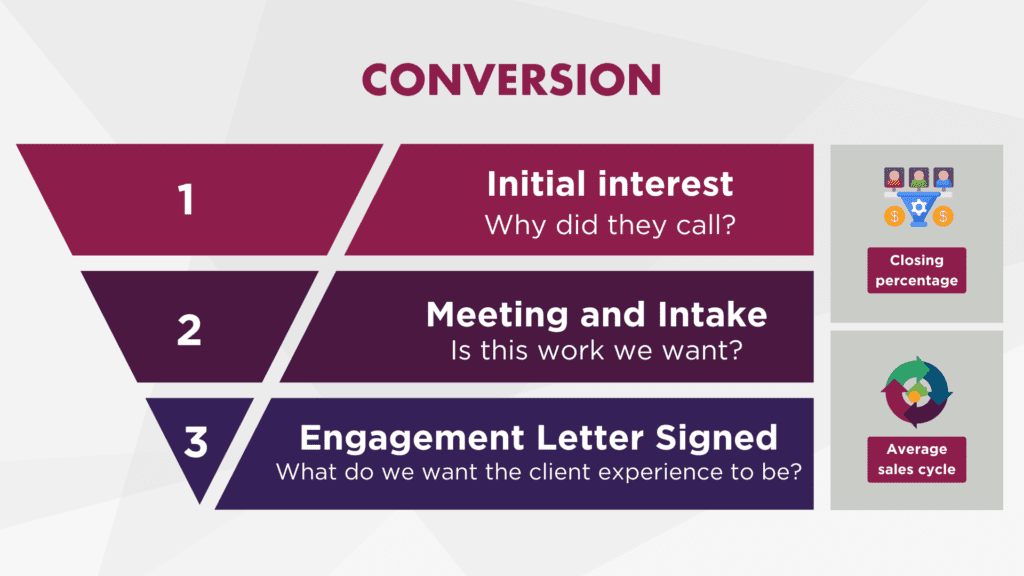No one likes a December surprise. Heading into January is the time to sit down and refocus on next year’s firm goals, not running around trying to collect outstanding bills because you came up short. This is where specific key performance indicators for law firms can help you uncover where things went wrong, and how you can modify your plan for next year’s growth goals.
When a law firm doesn’t hit their goals, the last thing you want is finger pointing to further derail you. A year-end check of these four key metrics – cash flow, production, pipeline and financials – will help you see exactly where things got off track – and which areas of strength you can lean on, going ahead, as you work to improve your firm’s performance.
Improve Cash Collections
Billing and collecting is no one’s favorite part of the job, but it’s key to every firm’s success. As a former partner of mine used to say, “You can’t eat AR (accounts receivable), and you can’t eat WIP (work in progress).”
Bill and collect on a regular cadence. Timely bills save you from that end-of-year scramble to collect, and they tend to be paid with less friction: According to the 2023 Legal Trends report by Clio, 28% of clients did not receive a bill from their attorneys in a timely manner, while 15% never received a bill at all. Partners who don’t bill regularly set you up for a struggle. Not only will late billing hurt collection rates, as clients are happier to pay for legal services they’ve recently received, the other partners are essentially financing operations in the meantime.
Consider: Do we have best practices for billing, and are we following them? Can a finance team member do the heavy lifting for partners, in terms of preparing bills? What part of the process can be automated? Are we making sure that all the billers adhere to billing and collecting on a regular cadence? If not, what are the consequences and how do we get them to comply?
Meet Charge Hour Expectations
The next area to diagnose is production: Are your utilization rates tracking according to expectations?
If the answer is yes, but your firm’s goals are still not being met, you need to look at your standard billing rate, to understand if you are charging enough for the services your firm provides. (You might even consider looking into different billing methods, like value-based billing.) Or, if your realization rate is low across the board compared with legal industry benchmarks, then you might consider improving processes and training for your team.
If your attorneys are not meeting charge hour expectations, then you have to answer a few more questions. Is the work there? If the work is there and people are not meeting their charge hour expectation, it suggests they aren’t being managed correctly and it may be time to look into improving processes and/or developing leadership capabilities. Remember, sacrificing billable hours can often be well worth the short-term cost: non-billable hours that are used to improve leverage pay dividends.
On the flip side, a shortage of work points to a problem with the next key performance indicator, as we’ll discuss below.
Dial in Your Client Pipeline Metrics
At any given point in the year, your entire staff should know how much client work they have available, as well as how much is paused because of a hold-up with a client. That means a dry or slow pipeline should never be a surprise.
If your people aren’t able to meet their weekly expectations because the firm doesn’t have enough work, it’s time to refocus on business development. That means asking questions such as: How do we get new clients? Who are our best clients? Where do they come from? Are we spending our business development efforts in the right areas? Are we getting a return on our investment?

You may need to revisit your marketing strategy: If you’ve been leaning on email marketing but your website traffic isn’t generating any inquiries, maybe that’s the wrong way to go. If you’re the subject matter leader but are struggling to get new business, maybe you need to develop or hone your content marketing strategy to become recognized as the subject matter leader. Pipeline metrics help make informed decisions about where to get the best return on investment.
We recommend breaking down your pipeline into segments: for example, “initial interest”, “meeting and intake”, and “signed engagement letter.” Two marketing kpis that you can determine from this process are: average sales cycle (how long it takes to move from interest to engagement) and conversion rate (what percentage of potential clients sign on)?
You also need to look at the economy in general: Is everyone experiencing a contraction in your area of law? Is it time to diversify practice areas ?
Another area to look at is your client acquisition and client satisfaction, which leads directly to your client retention rate. Ask yourself: Are you getting repeat work from current clients? Are you getting client referrals? If not, consider implementing processes to determine – and improve – client retention, by collecting client feedback, starting from your first sales call and onboarding.
Watch Financial KPIs All Year
Sometimes a major event can lead to a bad year – a partner walks out the door with their long client list, or a few too many cases don’t settle in your favor. But by preparing monthly financials and monitoring key performance indicators all year, you get the chance to diagnose problems early before they derail you.
There are multiple levers that any firm can pull when they aren’t meeting their financials. The common knee-jerk reaction is to cut costs, but before taking that approach, we recommend understanding why a firm missed their goals: If pipeline is down, spend more on marketing; or if production is off, improve efficiencies and utilize leverage.
Avoid December Surprises with Dynamic Forecasting
The benefit of a forecast is that it allows you to pace yourself throughout the year. If you’re updating your forecast and tracking KPIs on a monthly basis to reflect the actual results, you should know early in the year if you’re likely to hit your goals. If not, you can turn to the specific key performance indicators for law firms and make data-driven decisions to get back on track.
If you found this blog post helpful, we invite you to learn more about our Virtual CFO services for law firms.




